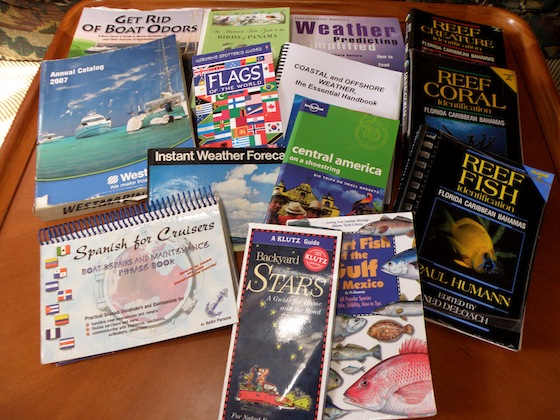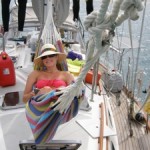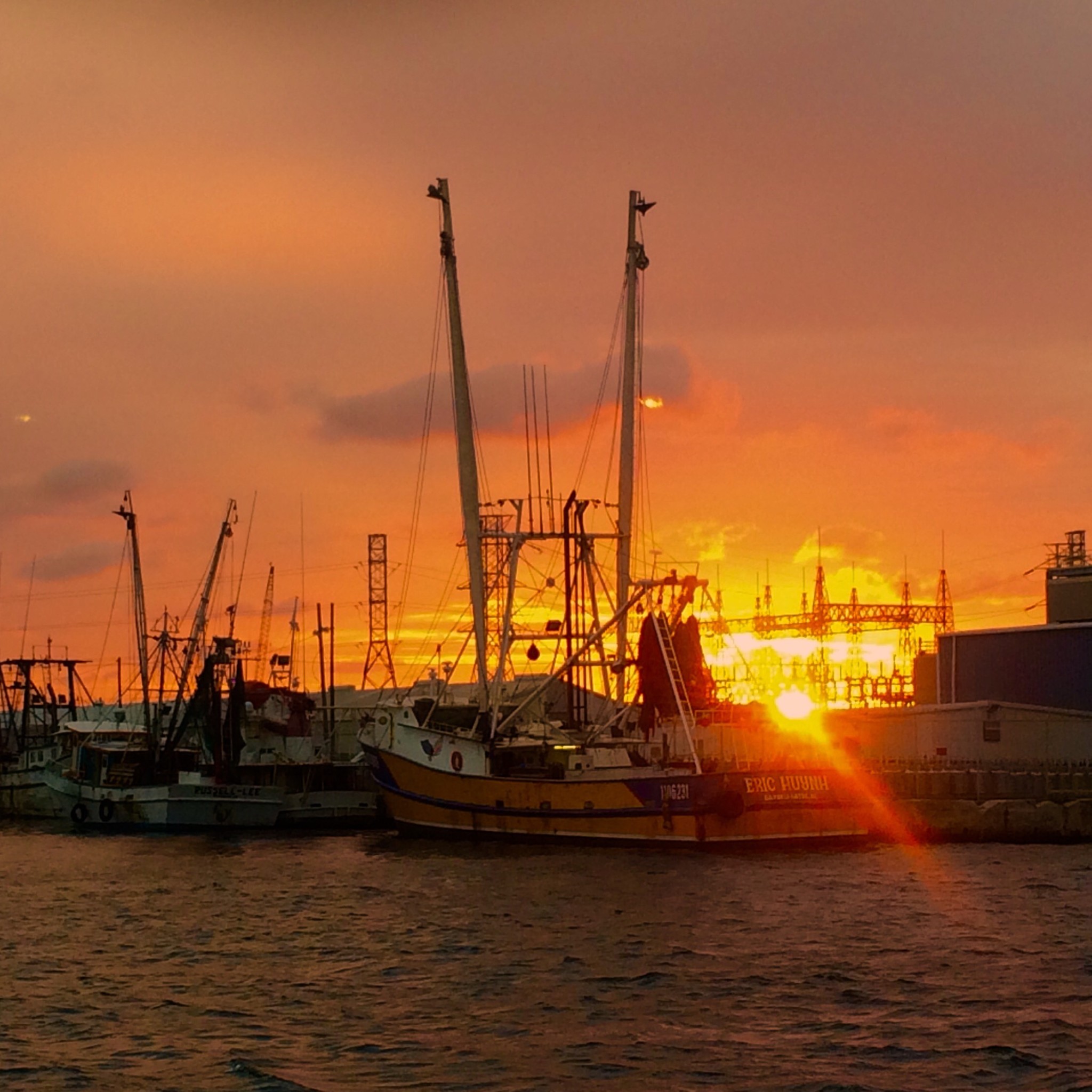Even before buying Winterlude, our 1985 Passport 37 sailboat, our bookshelves were full of “critical” books with titles like “Marine Diesel Engines”, Nigel Calder; “Boatowner’s Illustrated Electrical Handbook”, Charlie Wing and “Heavy Weather Sailing” by Adlard Cole.
Luckily our most dog-eared books are not technical manuals, but rather a diverse group of titles that enhance our enjoyment of life aboard. You may want to add these titles to your onboard library! NOTE: This originally appeared in Cruising World Magazine, August 2012 under the title “The Cruising Library” — online link here.
#1. Reef Fish Identification, by Paul Humann. (New World Publications, Inc., 2002, $39.95. Available from Amazon.) Fish identification books are a dime a dozen and we had several aboard. Unfortunately every time I discovered something new, I rarely found it, until buying this trilogy of ocean life books – “Reef Fish Identification”, “Reef Creature Identification” and “Reef Coral Identification.
Even if you’re not a snorkeler and never get in the water, you will enjoy identifying creatures swimming in the crystal clear water such as the neon Spotted Filefish hanging motionless by our anchor chain or the brilliant Blue Tangs and Sergeant Majors flitting around the dock.
This trilogy of books is organized by chapters with identification characteristics … small ovals, silvery, reddish with big eyes, making it easy to find the fish with a full color photo and additional information, including habitat and behavior, in one concise location. Because we love snorkeling, the Reef Fish book wins, hands down, the prestigious “Most Dog-Earred Book” Award!
#2. “Stokes Field Guide to Birds” by Donald & Lillian Stokes (Little, Brown and Company; 1996, $12.23 at Amazon) When the first frigate bird soars above your boat or a brown booby bird lands on your wind generator, you’ll wish you had a bird book aboard. We prefer books with full color photos (not illustrations) and information, habitat and range all in one place. “Birds of Panama” by Ernesto Ponce and Giselle Muschett (Ediciones Balboa, 2006, $50, available everywhere in Panama) provides a good guide to birds native to Panama.
#3 “Flags of the World, Usborne Spotter’s Guides” by William Crampton. (Usborne Books, 2006, $12, Available at Amazon). Before leaving U.S. waters, we rarely had the opportunity to puzzle over the national identity of boats in the anchorage. Now our flag book is consulted daily to identify nationalities. Of the eight boats in today’s anchorage, we have flags from Finland, Spain, Australia, Canada and the USA.
#4 “Sport Fish of the Gulf of Mexico” by Vic Dunaway. (Wickstrom Pub, 2000, $12, Available at Amazon) The first time our new trolling rod sang ZING, we reeled in a two foot long fish and scrambled – is this fish edible? We found our fish … a Spanish Mackerel, despite not being in the Gulf of Mexico. The full color photo made identification easy and the Food Value section in the description let us know dinner was on the hook.
#5 Weather. Curious about the clouds overhead, or the rainbow encircling the sun? A pamphlet called “Weather, An Introduction to Clouds, Storms and Weather Patterns” (Waterford Press, 2001, $6 at Amazon) or “Instant Weather Forecasting” by Alan Watts (Adlard Coles Nautical; 2007, $9 at Amazon) can help. “Instant Weather Forecasting” has full page photos of clouds and the facing page has a chart listing weather trends and timing associated with that cloud including wind, visibility, precipitation, temperature, and barometric pressure.
Other weather books are used as a reference manual for weather faxes, surface analysis charts and wind/wave charts. The best is “Weather Predicting Simplified”, by Michael Carr (International Marine,1999, $15 at Amazon).
Written by a sailor, it is useful for understanding weather forecasts, identifying unrecognized symbols on surface analysis and wind/wave charts, as well as providing basic information on learning to predict weather.
#6 A Star Guide .. our little “Backyard Stars, a Klutz Guide” (Klutz; 1998, n/a from Amazon) answers general “what is that bright star” questions but we’re still looking for the best guide. It may be that one of the new apps for smartphones or tablets provide the best info IF they work outside cell tower range. Skies in the tropics are so dazzling that you’ll want to know where and when to spot planets, stars, meteor showers and comets so you can relax on the deck taking in the heavenly star show.
#7 A Calendar. Cruisers tend to lose track of time saying things like “What day of the week is it?”
#8 “Spanish for Cruisers, Boat Repairs and Maintenance Phrase Book” by Kathy Parsons (Aventuras Publishing Company, 2000, $30 at Amazon) As any cruiser knows, the classic definition of cruising … “fixing your boat in exotic places” often requires communicating in other languages. In the Western Caribbean, “Spanish For Cruisers” not only provides the words and easy pronunciations, but also pictures. If all else fails and no one understands your Spanish, you can simply POINT at what you need! Probably the most essential chapter in the book is on emergency communications via the radio … communicating your position and difficulty/problem in Spanish could be vital to survival.
#9 “Get Rid of Boat Odors. A Boat Owner’s Guide To Marine Sanitation Systems and Other Sources of Aggravation and Odor” by Peggie Hall (Seaworthy Publications, 2003, $15 from Amazon). Containing a wealth of advice on anything smelly: if the bilge perfume will not go away, if you need a new head and don’t know which to buy, if you don’t know when to replace your sanitation hoses, this book is for you. It’s not as dog-eared as some of the other award winners, because thankfully, we don’t need it as often. But when it’s necessary, it is the most important book aboard!
#10. Instruction Manuals for everything on the boat, organized in an easy to access location. When we bought Winterlude, all the manuals were included, overstuffing two drawers. Finding a manual meant dumping out both drawers. Now accordian binders open to files allowing us to keep documentation handy for every system and file tabs make scanning easy. Along with instruction manuals, be sure to have a marine catalog such as West Marine to identify parts you may need to replace. Even if you can’t order from them out of the country, the photos are useful to identify what you need in local shops – pointing to a photo can facilitate wonders of getting parts in foreign ports!
Honorable Mention: Cruise Specific Information … of course the cruising guides and paper charts, but also books specific to your cruising area. Cruising the US East Coast, we had several guides, but enjoyed Claiborne Young’s cruising guides (various publishers, available at Amazon for $18-$26) for the extra information included – history, geography and attractions. While cruising Panama, we have “The Path Between The Seas”, the story of the building of the Panama Canal by David McCoullough (Simon & Schuster; 1978, $16 at Amazon); “The Art of Being Kuna” by Mari Lyn Salvador (University of Washington Press; 1997, out of print, check Amazon for used sellers) and “A People Who Would Not Kneel, Panama, The United States and the San Blas Kuna” by James Howe (Smithsonian; 1998, out of print, check Amazon for used sellers). Don’t forget a “regular” travel guide for inland travel. Try the Lonely Planet Shoestring Guides (Lonely Planet) for travel information, the Insight Guides (Insight) for area information and other Lonely Planet guides, such as “Watching Wildlife Central America” for specific subjects.
Do you have favorite dog-eared books aboard that are not “boat maintenance” or instructive books such as anchoring or heavy weather? Please leave a comment and share! Thanks! Jan















Thanks!